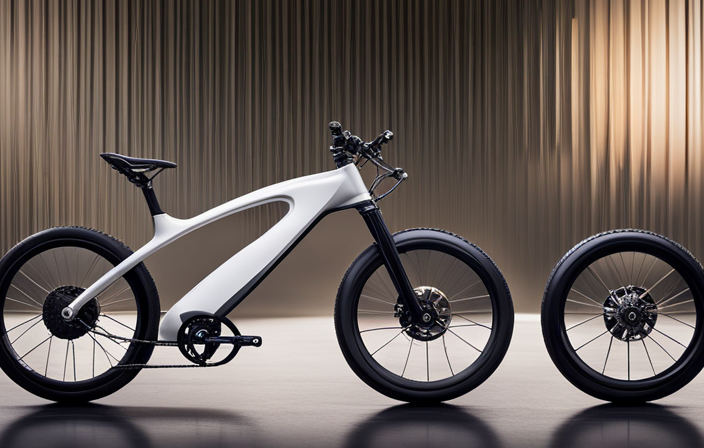I have always enjoyed the excitement of riding my electric road bike. However, there are times when I need to take out the battery for maintenance or charging. It can be a bit challenging if you are not familiar with the procedure.
That’s why I’m here to guide you through it step by step. From locating the battery compartment to disconnecting the wires, I’ll show you how to remove the battery with ease.
So, let’s get started and keep your electric road bike running smoothly!
Key Takeaways
- Turn off the bike and disconnect the battery from the power source.
- Locate and unlock the battery compartment.
- Gently slide the battery out of the compartment, avoiding damage to wires or connections.
- Follow the correct procedure to ensure safety during battery removal.
Turn off the power to the electric road bike.
Make sure to turn off the power to the electric road bike before attempting to remove the battery. This is a crucial step to ensure your safety and prevent any potential damage to the bike or yourself.
To turn off the power, locate the power button or switch on the bike and press or toggle it to the ‘off’ position. Once the power is off, you can proceed with disconnecting the wires from the battery. Depending on the bike model, you may need to use a screwdriver or wrench to loosen and remove any screws or bolts holding the wires in place. Take care to gently disconnect the wires, avoiding any unnecessary force or pulling.
Now that the power is off and the wires are disconnected, we can move on to the next step: locating the battery compartment or housing on the bike.
Locate the battery compartment or housing on the bike.
First, you’ll need to find where the battery is located on the e-bike. Common battery compartment locations on electric road bikes include the downtube, rear rack, and seat tube. The battery compartment is usually secured with screws or bolts, so you may need a screwdriver or Allen wrench to access it.
Once you’ve located the battery compartment, it’s important to safely handle the battery. Make sure the power to the bike is turned off before removing the battery. To remove the battery, gently unplug any connectors and carefully lift it out of the compartment. Be mindful of the weight and balance of the battery to prevent any accidents.
Now, you can move on to the next step and check if there are any locks or latches securing the battery in place.
Check if there are any locks or latches securing the battery in place.
After locating the battery compartment, make sure to check for any locks or latches securing it in place. Battery removal precautions should always be followed to ensure safety and prevent damage.
Here are some battery maintenance tips to keep in mind:
- Inspect the battery compartment for any signs of corrosion or damage.
- Ensure that the bike is powered off before attempting to remove the battery.
- Use the appropriate tools, such as a screwdriver or Allen wrench, to unlock the latches or remove any screws holding the battery in place.
Taking these precautions will help prevent any accidents or damage during the battery removal process.
If there are locks or latches, release them to unlock the battery. This will allow you to safely proceed with the next steps in the battery removal process.
If there are locks or latches, release them to unlock the battery.
If there are locks or latches securing it, simply release them to unlock the battery. This is an important step in the battery removal process for an electric road bike.
Before proceeding, it’s crucial to take safety precautions. Make sure the bike is turned off and the power is disconnected. Additionally, wearing protective gloves is recommended to prevent any potential accidents.
Once the locks or latches are released, carefully lift the battery out of its compartment. Keep in mind that batteries can be heavy, so it’s a good idea to use proper lifting techniques to avoid strain or injury.
Now, with the battery removed, it’s time to move on to the next step: carefully disconnect any wires or cables connected to the battery.
Carefully disconnect any wires or cables connected to the battery.
To safely disconnect any wires or cables, make sure you have a firm grip and gently pull them away from the battery terminals.
Here are some essential lifting precautions and proper storage guidelines to ensure the safe removal of the battery from an electric road bike:
- Use proper lifting techniques, keeping your back straight and using your legs to lift the battery.
- Place the battery in a cool, dry location to prevent damage and extend its lifespan.
- Store the battery in a well-ventilated area away from flammable materials.
By following these guidelines, you can prevent any potential injuries and ensure the longevity of your electric road bike’s battery.
Once the wires and cables have been disconnected, it is crucial to double-check that all connections are unplugged before proceeding to the next step.
Double-check that all connections are unplugged before proceeding.
Make sure all connections are unplugged before moving forward.
Proper battery storage is important to maintain the longevity and performance of your electric road bike.
When removing the battery, there are a few common mistakes to avoid.
First, always double-check that all connections, such as wires or cables, are unplugged to prevent any potential damage.
It’s crucial to handle the battery with care and avoid dropping it or exposing it to extreme temperatures.
Additionally, be cautious not to touch any exposed wires or terminals to prevent any electrical shocks.
Taking these precautions will help ensure a smooth and safe battery removal process.
Now, let’s move on to the next step: hold the battery firmly and lift it out of the compartment.
Hold the battery firmly and lift it out of the compartment.
Now, you’ll want to grip the battery securely and lift it out of the compartment. When lifting the battery, it’s important to use proper techniques to ensure safety and to avoid any strain or injury. Here are some key points to keep in mind:
- Maintain a balanced stance with your feet shoulder-width apart.
- Engage your core muscles to support your back and maintain proper posture.
- Bend your knees and use your leg muscles to lift the battery, rather than relying solely on your back.
- Keep the battery close to your body to minimize strain on your arms and back.
- Avoid twisting or jerking movements while lifting and carrying the battery.
By following these lifting techniques, you can ensure a smooth removal of the battery from the compartment without any mishaps.
Be mindful of the weight of the battery and use proper lifting techniques to prevent any injuries or accidents.
Be mindful of the weight of the battery and use proper lifting techniques.
Be sure to pay attention to the weight of the battery and employ correct lifting techniques to prevent any injuries or accidents.
Proper battery maintenance is essential for the longevity and performance of your electric road bike.
When removing the battery, it is crucial to be mindful of its weight as it can vary depending on the model and capacity. Using a battery cover adds an extra layer of protection and prevents any damage during the process.
Start by gripping the battery firmly with both hands, making sure to distribute the weight evenly. Lift the battery straight up and out of the compartment, using your legs and not your back to avoid strain.
Once the battery is safely removed, it is important to place it in a safe and secure location, away from any potential hazards or extreme temperatures.
Place the battery in a safe and secure location.
Ensure that you store the battery in a secure and safe location, away from any potential hazards or extreme temperatures. Proper battery maintenance is crucial to prolong its lifespan and ensure optimal performance.
When it comes to battery charging tips, it is important to follow the manufacturer’s instructions and use the recommended charger. Avoid overcharging the battery, as this can lead to decreased capacity and potential damage.
Additionally, make sure to keep the battery clean and free from dirt or debris, as this can affect its performance. If you plan to store the battery separately, ensure it is in a cool and dry place. This will help preserve its integrity and prevent any damage caused by moisture or excessive heat.
If you plan to store the battery separately, ensure it is in a cool and dry place.
For optimal battery storage and maintenance, it is crucial to place the battery in a cool and dry location. This will help to prolong its lifespan and ensure optimal performance. Here are some key points to consider:
-
Temperature: Keep the battery in an area with temperatures between 50°F and 77°F (10°C and 25°C) to prevent overheating or freezing.
-
Humidity: Avoid storing the battery in high humidity environments, as moisture can damage its internal components.
-
Storage Container: Consider using a storage container that provides both protection from physical damage and insulation from temperature and humidity fluctuations.
-
Charging Level: Before storing the battery, make sure it is at a charge level between 40% and 60% to prevent overdischarge or overcharging.
If you need to replace the battery, consult the manufacturer’s instructions for the specific model.
After ensuring that the battery is stored in a cool and dry place, it is important to understand the proper procedure for battery replacement and maintenance. If you find yourself in need of replacing the battery, it is crucial to consult the manufacturer’s instructions for the specific model of your electric road bike.
Each model may have different requirements and procedures for battery replacement. Following the manufacturer’s instructions will ensure that you perform the replacement correctly and minimize the risk of damaging the battery or the bike itself.
Additionally, it is essential to maintain the battery properly to prolong its lifespan and optimize its performance. This includes regularly checking the battery’s charge level, cleaning the battery terminals, and avoiding extreme temperatures.
When reattaching the battery, make sure all connections are secure and properly plugged in.
When reattaching the battery, make sure all connections are secure and properly plugged in.
When reattaching the battery, it’s important to double-check that all connections are secure and properly plugged in. Battery maintenance is crucial for maximizing battery lifespan. Here are some key steps to ensure the battery is reattached correctly:
- Inspect the battery terminals for any dirt or corrosion and clean them if necessary.
- Align the battery connectors with the corresponding ports on the bike frame.
- Gently push the battery into place until it clicks securely.
By following these steps, you will ensure a reliable connection and optimize the performance of your electric road bike.
Once the connections are secure, you can proceed to verify that the battery is correctly aligned in the compartment before locking it in place.
Verify that the battery is correctly aligned in the compartment before locking it in place.
Before locking the battery in place, double-check that it is correctly aligned in the compartment. Battery alignment is crucial for proper functioning and safety of the electric road bike.
To remove the battery, locate the release mechanism, usually located on the side or bottom of the battery. Gently push or slide the release mechanism to unlock the battery from its position. Once unlocked, carefully lift the battery out of the compartment, making sure to support its weight. Inspect the battery and compartment for any signs of damage or debris. Clean the contacts if necessary.
When reattaching the battery, align it with the compartment and gently slide it in until it locks securely.
Now that the battery is in place, it’s time to test the electric road bike to ensure the battery is functioning properly.
Test the electric road bike to ensure the battery is functioning properly.
Now that the battery is securely locked in place, it’s time to check if the electric road bike is functioning properly. Here are some testing methods and troubleshooting tips to ensure everything is in working order:
-
Turn on the bike’s power switch and check if the display screen lights up. This indicates that the electrical system is receiving power.
-
Test the throttle and brakes to ensure they are responsive. A smooth and immediate response is essential for safe riding.
-
Take a short test ride to check the motor’s performance. Pay attention to any unusual noises or vibrations.
-
Monitor the battery level and range indicator to ensure they are accurate and consistent.
If you encounter any issues or difficulties during the testing process, it’s recommended to consult a professional or the manufacturer for assistance. They can provide further guidance and resolve any problems that may arise.
If you encounter any issues or difficulties, consult a professional or the manufacturer for assistance
If you have any issues or difficulties, it’s best to consult a professional or the manufacturer for assistance.
When it comes to removing the battery from an electric road bike, it’s important to follow the correct procedure and take safety precautions.
First, ensure that the bike is turned off and the battery is disconnected from any power source.
Locate the battery compartment, which is usually located near the bottom of the frame or inside the bike’s downtube.
Depending on the bike model, you may need to use a key or a tool to unlock the battery.
Once unlocked, gently slide the battery out of the compartment, being careful not to damage any wires or connections.
Remember to always handle the battery with care and avoid any excessive force or impact.
Properly store the battery in a cool, dry place when not in use.
Frequently Asked Questions
How do I turn off the power to the electric road bike before removing the battery?
To power off an electric road bike before removing the battery, it is essential to follow safety precautions. First, ensure the bike is turned off by locating the power switch or button. Then, carefully disconnect the battery, taking care not to damage any wires or connections.
What should I do if I cannot locate the battery compartment or housing on my electric road bike?
If you can’t find the battery compartment on your electric road bike, don’t worry. There are alternative battery locations that vary depending on the model. If you’re experiencing battery issues, troubleshooting common problems can help identify the issue.
Are there any specific tools or equipment required to release the locks or latches securing the battery?
To release the locks or latches securing the battery, you may need a set of Allen wrenches or a screwdriver, depending on the bike model. Follow the manufacturer’s instructions for proper battery removal and installation.
What precautions should I take when disconnecting the wires or cables connected to the battery?
When disconnecting the wires or cables from the battery, it is important to take certain precautions for safety. Ensure the bike is turned off and wear protective gloves. Carefully remove the connectors, avoiding any accidental short circuits or damage to the wires.
How can I test if the battery is functioning properly after reattaching it to the electric road bike?
To test the functionality of the battery after reattaching it, I recommend using various testing methods such as voltage measurement, load testing, and analyzing battery maintenance records. These techniques will help ensure your battery is in optimal condition.
Conclusion
So there you have it, removing the battery from an electric road bike is a fairly straightforward process. By following the steps outlined above, you can safely and efficiently detach the battery from your bike.
Remember to always turn off the power before starting, and be cautious when disconnecting any wires or cables.
Once you’ve reattached the battery, take the time to ensure all connections are secure and properly plugged in. Finally, test the bike to ensure the battery is functioning correctly.
If you encounter any difficulties, don’t hesitate to seek assistance from a professional or the manufacturer. As the saying goes, ‘A smooth ride starts with a well-maintained battery.’
















